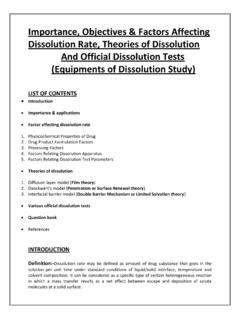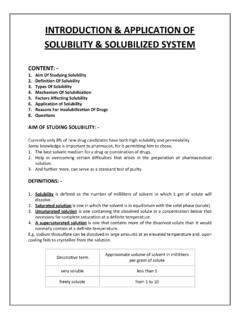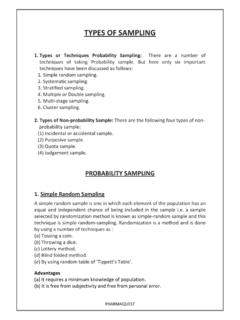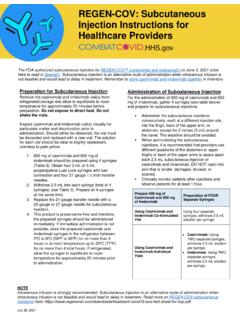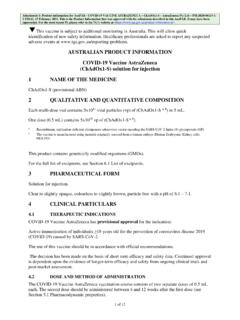Transcription of FORMULATION AND EVALUATION OF VARIOUS COSMETIC …
1 FORMULATION AND EVALUATION OF. VARIOUS COSMETIC AND DENTAL. PRODUCT. 1) DEFINITION:- The term cosmetics have been derived from the term COSMETIKOS which means the skill to decorate. Thus cosmetics is the art of decorating yourself to look beautiful. According to D & C Act:- Cosmetics mean any articles meant to be rubbed, poured, sprinkled or sprayed on or introduced into or otherwise applied to any part of the human body for cleansing, beautifying, promoting attractiveness or altering appearance and include any article intended for use as a component of COSMETIC . Soap is not covered under COSMETIC product. 2) CLASSIFICATION OF COSMETICS:- 3) INGREDIENTS OF COSMETICS:- 1. Water 2. Oils, Fats, Waxes 3. Humectants PHARMAQUEST. 4. Surfactants 5. Preservatives 6. Perfumes And Colors 7. Herbal Or Plant Material 8.
2 Functional Raw Materials 1. WATER:- It is the main ingredient of cosmetics FORMULATION . Thus stability and quality of final product is dependent on the purity of water used so pure water should be used in manufacturing of cosmetics. Pure water on large scale can be manufactured by any of the methods mentioned below. Ion exchange system Distillation Reverse osmosis 2. OIL, FATS and WAXES:- These are used in preparation of creams, lotions, brilliantine, hair oil, lipsticks etc. The source of oil, fat & wax can be mineral source & animal source. The source and example is given below. Source:-1) Mineral source -mineral oil -paraffin and petroleum jelly 2) Animal source -wool fat -bees wax, Spermaceti OILS:- Name of oil (Vegetable). Use in cosmetics Almond Creams (emollient). Arachis Hair oil, Brilliantines Castor Lip stick, hair oil cream ,lotion Olive Bath oils ,creams lotions Type of mineral oil Use in cosmetics product Light liquid paraffin In bath oil, hair oil,lotions,creams,brilliantine In bath oil, hair oil,lotions,creams,brilliantine Heavy liquid paraffin (emollient).
3 Waxes:- The commonly used waxes in preparation of cosmetics Include bees wax, spermaceti,ceresin,ozokerite wax 3. HUMECTANTS:- This is added to prevent drying out of cosmetics PHARMAQUEST. ( o/w creams). Type of Humectant Examples Calcium chloride (not used now due to compatibility problems). Sodium lactate (used in sunscreen lotions). organic Polyethylene glycol, Propylene glycol, glycerol, sorbitol, mannitol, glucose 4. SURFACTANTS: Surfactants lower one or more boundary tensions at interface in the system. one common feature of surfactant is that they all are amphipathic molecules containing a hydrophobic part & a hydrophilic part. Used in cosmetics to impart following functions:. DETERGENCY, WETTING, FOAMING, EMULSIFICATION, SOLUBILIZATION. Surfactants on basis of their ionic behavior can be divided into following 4 types:- Type of surfactant Examples Fatty acid soaps, alkyl sulphates, alkyl sulphonates, polyethylene glycol ester,alkyl ether sulphates taurines,sarcosinates etc.
4 Alkyl trimethyl ammonium salts, Dialkyl dimethyl ammonium salts alkyl pyridinium salts, quaternised diamine salts. Alkanolamides,alkyl polyglycol ether, thioethers, 3. Non ionic alkyl polyethyleneimine amides. Betains, alkylimidazolines, acyl peptides,etc. 5. PRESERVATIVES:- Used to prevent spoilage which occurs due to 1) Oxidation of oils 2) Microbial growth Unused cosmetics are usually contaminated wit PSEUDOMONAS but used cosmetics are contaminated with STAPHYLOCOCCI,FUNGI,YEAST. Types of preservatives :- 1) Anti microbial agents:- .Benzoic acid, formaldehyde, cresol, phenol, thiomersol,phenyl mercuric salts. Etc. 2) Antioxidants :- Gallic acid, methyl gallate,BHA,BHT,Tocopherol, citric acid,Ethanolamine,lecithin,ascorbic acid, sodium sulphite, Sodium metabisulphite 3) Antioxidant synergists: - Enhance the efficacy of antioxidants.
5 Examples include:-ascorbic acid, citric acid, phosphoric acid 4) UV absorbers:-These are mainly used in products which are vulnerable to visible or UV light. By incorporating UV absorbers colorless containers can be used if deterioration is due to UV light only. PHARMAQUEST. 6. PERFUMES:- The word perfume has been derived from per means through and fumum means smoke. It suggests that early perfumes were pleasant smells obtained by burning wood and grass etc. Source of perfume Example Natural Musk ,civet, Ambergris, Castroreum etc. (Animal source). Natural Rose ,jasmine, lemon, lavender etc. (Plant source). Aroma chemical Eugenol, Farnesal, Rose oxide, Citral ,Limonene Floral base Rose base, Jasmine base Citrus base(in colognes),spice base, oriental base, Woody base fruity base ,etc 7.
6 COLORS:- It defined as visual sensation caused by a definite wavelength by an object by one/more phenomenon of emission, reflection, refraction, transmission. Colors can be classified into three classes:- a) Natural colors:- Plant source :- Saffron, turmeric Animal Cochineal (red). b) Inorganic colors:- Iron oxides, chromium oxides, carbon black, titanium dioxide, zinc oxide etc. c) Coal tar colors:-Tartrazine, amaranth, Erythrosine, Indigocarmine. etc. OR PLANT MATERIAL:- These herbal or plant materials are used in different cosmetics preparations. NAME USE IN COSMETICS. Almond Facial and body scrubs Azadiracta Tooth paste and skin care Comfrey Creams and lotions Tulsi Skin cream and lotions Cucumber Masks, toner, cleanser Henna Dyeing of hair Amla Shampoo Jasmine Hair oil Lemon Skin tonic, cleansers PHARMAQUEST.
7 Apricot Facial and body scrubs 9. FUNCTIONAL RAW MATERIALS:- These agents contribute towards some functional property . TYPE EXAMPLE & USE. Vit C (antioxidant in emulsion),vit A, VITAMINS Vit E (skin beautification). AV HILL MP TT. AMINO ACIDS. (all essential amino acids). ANTI INFLAMMATORY Allantoin (hand cream & lotion) Cade oil(eczema&. AGENTS psoriasis),Calamine SUNSCREEN PABA, Vitamin C, Quinine salts AGENTS Coumarin derivatives ANTIDANDRUFF Selenium, cadmium sulphide, ZPTO. (4) FORMULATION . COSMETICS FOR SKIN. Function:- 1) To provide decoration 2) To supplement natural functions of skin Type of cosmetics used for skin:- 1. Skin cream 2. Lotion 3. Face powder & Compacts 4. Skin colorants 5. Body powder 6. Face pack & Masks 7. Bath Preparations (bath salt,oil,powder,foam). 8. Astringents &Skin tonics (antiperspirants, astringent lotion, preshave & after shave lotion, colognes).
8 1. CREAMS: - These are the solid or semisolid preparation which is either a o/w or w/o type emulsion. TYPES OF CREAMS: A. Cleansing cream B. Massage creams C. Night creams D. Moisturizing creams PHARMAQUEST. E. Foundation creams F. Vanishing creams G. All purpose creams A) CLEANSING CREAM:- Cleansing cream is required for removal of facial make up, surface grime, oil, water and oil soluble soil efficiently mainly from the face & throat. Characteristic of a good cleansing cream:- 1) Be able to effectively remove oil soluble & water soluble soil, surface oil from skin. 2) Should be stable &have good appearance. 3) Should melt or soften on application to the skin 4) Should spread easily without too much of drag. 5) Its physical action on skin & pore openings should be that of flushing rather than absorption Type of cleansing cream:- I.
9 Anhydrous type:- It contains mixture of hydrocarbon, oils and waxes. It also contains cetyl alcohol, spermaceti, cocoa butter, fatty acid esters etc. Not popular. Mineral oil-80 gm, Petroleum jelly 15gm Ozokerite wax -5 gm preservative and perfumes Note :- Formation crusty surface is avoided by adding Ozokerite & petrolatum (prevent bleeding of mineral oils.). Opaque character obtained by adding Zno, , Tio2. II.) Emulsified type:- They can be either o/w or w/o type. Common Ingredients:- Oil phase ..Spread easily Waxes ..Give appropriate thixotropy Emollient material likes cetyl alcohol, spermaceti, lanolin Water phase with preservative Different types:- (1) Cold Cream:- Cooling effect is produced due to slow evaporation of the water contained in the FORMULATION . These are w/o type. (2) Beeswax Borax type:- These contain high percentage of mineral oil.
10 These are o/w type. This cream contains high amount of mineral oil for cleansing action. Basically these are o/w type emulsion. After the cream is being rubbed into the skin sufficient quantity of water evaporates to impart a phase inversion to the w/o type. The solvent action of the oil as external phase imparts cleansing property. In this type of cream borax reacts with free fatty acids present in the bees wax and produces soft soap which acts as the emulsifying agent and emulsifies the oil phase . A typical FORMULATION :- Bees wax -2 gm Borax-2 gm Almond oil -50 gm Rose water gm Lanolin preservative and perfume PHARMAQUEST. B) NIGHT & MASSAGE CREAM:- These are generally applied on the skin and left for several hours say overnight and assist in the repair of skin which has been damaged by exposure to VARIOUS elements or exposure to detergent solution or soap.
